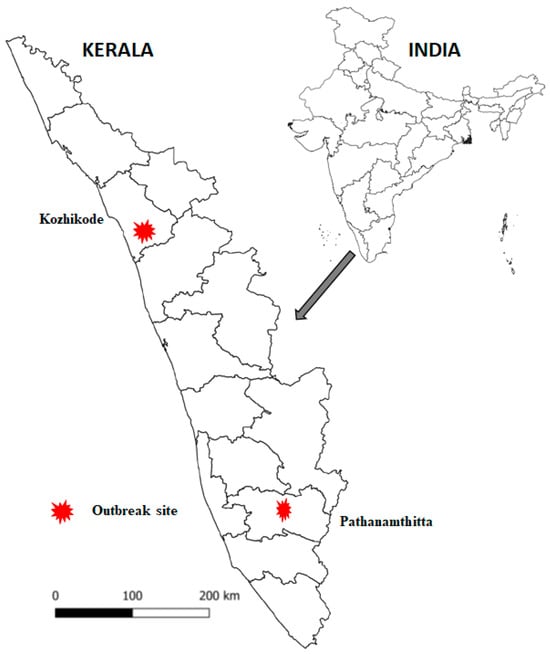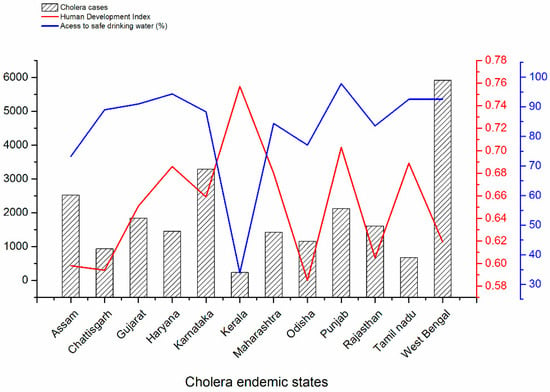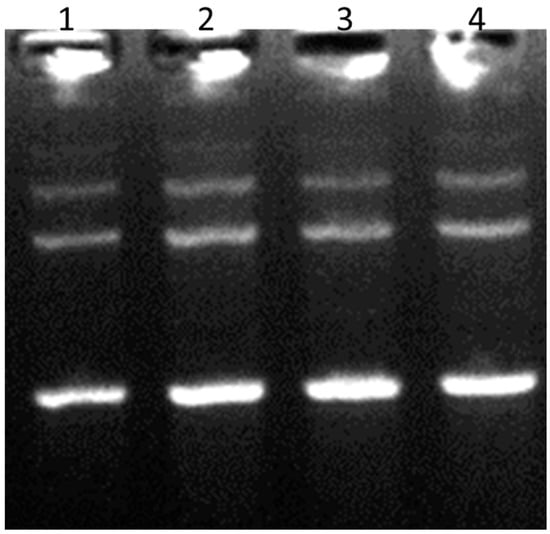Abstract
Cholera outbreaks are prevalent in countries with a low Human Development Index (HDI) where people have limited access to safe drinking water, sanitation and hygiene (WASH). Intriguingly, the state of Kerala which records the highest HDI in India is endemic to cholera. We discuss the epidemiology of a cholera outbreak reported among migrant workers of Kerala in 2017. Virulence genes of Vibrio cholerae, toxR and ctxA, were detected in the river and ground water samples collected from the outbreaks sites which indicates need of enhanced awareness on WASH practices among migrant workers. The pathogenic Vibrio cholerae isolated from four patients in two districts had a similar DNA band pattern when analysed using repetitive extragenic palindromic-PCR (BOX), which indicates their single clonal origin. The four isolates were serotyped as O1 Ogawa. These isolates were resistant to multiple antibiotics including the carbapenem like imipenem. Nevertheless, isolates of these pathogenic bacteria were susceptible to tetracycline, identical to clinical isolates of Vibrio cholera reported earlier from this region. The current study highlights the importance of generating awareness on WASH protocols among migrant workers to prevent the outbreaks and considers community-based data as socioeconomic variable to predict the incidence of cholera.
1. Introduction
Cholera, an acute diarrhoeal disease caused by water associated pathogen Vibrio cholerae, infects a major share of world population exposed to poor water, sanitation and hygiene (WASH) facilities [1]. Many developed countries could prevent the outbreak of disease following the WASH procedure, which was first linked to the epidemiology of this disease by John Snow in 1854 [2]. The World Health Organization (WHO) has proposed several strategies to eliminate disease transmission by 2030, among which the important one is WASH [3]. However, several populations in Asia and Africa are deprived of access to safe drinking water and sanitation due to low socio-economic conditions represented by a low Human Development Index (HDI) [4] and pollution. The Indian subcontinent has been the homeland of Asiatic cholera from where the major pandemics of this disease originated and disseminated along with human migration and trade to different regions of the world [5]. According to the infectious disease surveillance programme (IDSP), 13 states of India are endemic to cholera [6]. Intriguingly, this list includes the state of Kerala, which records the highest HDI in the country [7] where an outbreak was reported among migrant workers in 2017. Among the four people diagnosed with cholera, one succumbed to death.
Though the first line treatment for cholera is oral rehydration therapy, antibiotics are also prescribed to reduce the severity of its symptoms such as water loss as well as shedding of the pathogen from the patient. Epidemiological studies revealed that chemoprophylaxis contributed substantially to the emergence of new clones of Vibrio cholerae often displaying reduced susceptibility to multiple antibiotics forming a major impediment in treatment of this disease [8]. The emergence of multiple antibiotic resistant cholera pathogens and reports on climate associated changes, such as global warming and flooding associated with torrential rains, favouring the incidence of cholera are alarming. It is important to characterize the isolates responsible for each outbreak to understand the evolution of Vibrio cholerae and its disease pattern. In this regard, our study deals with the epidemiological investigations of cholera outbreak among migrant workers as well as the antibiotic resistance profile of Vibrio cholerae isolated from infected individuals.
2. Materials and Methods
The water samples (25 mL) collected from the river and ground water source in the affected areas were enriched in alkaline peptone broth (225 mL) for 24 h at room temperature (Figure 1). Subsequently, an aliquot (1.5 mL) of the enriched broth was transferred into a microcentrifuge tube and the cells were separated by centrifugation at 8000 rpm for 10 min. The cells were suspended in 100 µL of TE buffer (pH—8) and lysed by being kept in a boiling water bath for 10 min followed by cold shock. Cell lysate thus prepared was further centrifuged at 7000 rpm for 10 min at 4 °C and supernatant was used as template DNA for PCR. Alongside, the clinical isolates of Vibrio cholerae were cultivated in Luria-Bertani (LB) broth and the genomic DNA was extracted by following CTAB-NaCl method [9]. DNA samples were further analysed for the presence of virulence genes, toxR and ctxA, of Vibrio cholerae using primer sets specific for toxR (F—5′ CCTTCGATCCCCTAAGCAATAC 3′; R—5′ AGGTTAGCAACGATGCGTAAG 3′) and ctxA (F—5′ AAC TCA GAC GGG ATT TGT TAG GC 3′; R—5′ TCT CTG TAG CCC CTA TTA CGA TGT 3′) [10]. BOX-PCR was also used for phylogenic grouping of clinical isolates of Vibrio cholerae from different sources. Here the palindromic regions in the DNA of each organism were amplified using BOX A1R primer 5′-CTACGGCAAGGCGACGCTGACG-3′ [11].

Figure 1.
Map showing districts wherein cholera outbreak was reported in Kerala.
Serotyping of the clinical isolates of Vibrio cholerae were determined as agglutination over glass slides with polyvalent O1 antiserum, monovalent serotypes of Inaba, Ogawa and antiserum of O 139 (Denka Seiken, Tokyo, Japan). The clinical isolates of Vibrio cholerae were also screened for their antimicrobial susceptibility using the Kirby-Bauer disk diffusion method on Mueller-Hinton Agar. Isolates were tested against 15 antimicrobial drugs as follows: ampicillin (25 µg), tetracycline (30 µg), erythromycin (15 µg), gentamicin (30 µg), trimethoprim (30 µg), cefalexin (30 µg), cefepime (30 µg), cefoxitin (30 µg), ceftriaxone (30 µg), chloramphenicol (30 µg), gatifloxacin (5 µg), imipenem (10 µg), moxifloxacin (5 µg), nalidixic acid (30 µg) and norfloxacin (10 µg) (all Hi media Labs, Mumbai, India). The isolates were classified into resistant or sensitive based on zone of inhibition interpreted as per manufacturer’s instructions.
3. Results & Discussion
Water samples collected from the river and ground water sources in the cholera infected regions were found harbouring virulence genes of Vibrio cholerae. Disease incidence had been reported only among migrant workers and were not transmitted to local population. This could have happened because of two reasons: (1) They might have carried the disease from their home town or (2) they might have consumed the contaminated water without boiling or not followed the WASH protocols. Cholera outbreaks have been reported among migrant workers and refugees in several areas across the globe and have been attributed to overcrowding, limited access to safe drinking water and poor sanitation and hygiene practices [12,13,14]. The living conditions of migrant labourers are poor in Kerala with several people sharing single rooms with less provision of hygiene sanitation [15]. The high population density (860 persons/km² according to census 2011 data), less availability of safe drinking water (Figure 2), prolonged monsoon and prevalence of Vibrio cholerae in the surface water makes the region endemic to cholera. The environmental monitoring studies conducted in this area also confirmed the prevalence of Vibrio cholerae in the aquatic environments thorough out the year [16]. Water associated diseases are considered one of the major reasons for reduced man working days in the region [17]. However, deaths due to cholera are fewer in Kerala compared to other endemic states in India, attributed to its high HDI (Figure 2) achieved through various public health measures taken in the past few decades such as vaccination campaigns, sanitation, water supply and personal environmental hygiene [18].

Figure 2.
Cumulative cholera case (2010–2015) in 12 endemic states of India plotted against their respective Human Development Index and % of population access to safe drinking water.
Further analysis showed that all the four clinical strains of Vibrio cholerae isolated from Kozhikode and Pathanamthitta were pathogenic harbouring toxR and ctxA genes and serological analysis grouped them as O1, Ogawa. The pathogenicity of Vibrio cholerae is controlled by the synergistic effect of different genes initiated by the transcriptional activator toxR which initiates a cascade of gene expressions leading to the production of cholerae toxin encoded by ctxA and ctxBgenes. The BOX-PCR pattern showed that the Vibrio cholerae isolated from infected persons in distant regions (Kozhikode and Pathanamthitta) were the same clone with similar band patterns (Figure 3).

Figure 3.
Agarose gel image of the BOX-PCR patterns of V. cholerae isolated from Pathanamthitta (lane 1) and Kozhikode (lane 2, 3 and 4).
All four clinical isolates of Vibrio cholerae were resistant to multiple antibiotics with surprisingly a more or less similar susceptibility profile (Table 1).

Table 1.
Antibiotic resistance profile of clinical Vibrio cholerae isolates.
All isolates were susceptible to tetracycline, one of the mainstream drugs used worldwide for the treatment of cholera in adults. The resistance of Vibrio cholera—against this antibiotic is often reported sporadic from Indian subcontinent. Vibrio cholerae isolated from a previous outbreak in Kerala do confirm the same [19]. The consistent susceptibility of Vibrio cholerae isolates towards tetracycline should be welcomed as it indicates that this antibiotic is still effective against this pathogen found in these regions. Alarmingly, all the isolates were resistant to cell wall synthesis inhibiting antibiotics tested belonging to penicillins (ampicillin) as well as first to fourth generations of cephalosporins (cephalexin, cefoxitin, ceftriaxone and cefapime) and carbapenem (imipenem). Reports of Vibrio cholerae strains attaining resistance against first generation cephalosporin like cephalexin dates back as early as 2000. Whereas the resistance of a Vibrio cholerae against third generation cephalosporin (ceftrioxine) was earlier reported from south India and was attributed to the activity of either extended spectrum of β-lactamase (ESBL) or Amp C β-lactamase [20]. The growth of cephalosporin resistant microorganism is often inhibited by usage of antibiotics belonging carbapenem family. However, in this case, all the isolates of Vibrio cholerae showed resistance to imipenem, the carbapenem class of antibiotic, making these isolates further similar to aforementioned strain isolated from south India. Studies in future to understand the emergence of cephalosporin resistance among Vibrio cholerae should be appreciated, as these antibiotics are not generally prescribed as therapeutic agents for cholera.
All four isolates were also resistant against DNA synthesis inhibitor antibiotic belong to the class of first- and second-generation quinolones (Nalidixic and norfloxacin) tested. Long term studies conducted at the National Institute of Cholera and Enteric Disease (NICED) reveal that resistance of Vibrio cholerae isolates observed against nalidixic and norfloxacin was acquired as early as 1994 and 2000, respectively [21]. Except one isolate from Kozhikode, all remaining isolates were resistant against latest generation fluoroquinolones tested, specifically Gatifloxacin and Moxifloxacin. The resistance of Vibrio cholerae isolates against gentamicin is of concern as they are reported seldom globally. Out of 25 clinical isolates of Vibrio cholerae from a previous outbreak in Kerala, only one emerged resistant to this antibiotic (10 mcg) at a concentration tested threefold lower than our current study [19]. Hence the current results should be noted with caution. Most strains isolated from India were resistance to trimethoprim, whereas susceptibility to chloramphenicol and erythromycin, though reported, were low in incidence.
Sustainable availability of low skilled jobs with high wage structure (Rs ~600/day, double the national average) and other welfare schemes in Kerala is an attraction to migrant workers from other states, which is indicated by the increase in their number from 2.5 in 2013 to 4.0 million in 2017 [22]. Poor WASH practice, less concern about sanitation and hygiene prevailing in the residential areas of these population may trigger the cholera outbreaks in a state like Kerala, where Vibrio cholerae are prevalent in the environment. Our study indicates the need for providing decent accommodation and sanitation facilities to migrant workers and conducting awareness programs on WASH procedure to prevent the cholera outbreaks in future. Also, is important to consider community-based data as a socioeconomic variable to predict cholera outbreaks in the country.
Acknowledgments
The authors thank the Director, CSIR-National Institute of Oceanography, Goa and Scientist-in-Charge CSIR-NIO regional centre, Kochi, for extending all required support. This research was funded by India-UK water quality research program under the Department of Science and Technology (DST) and the Natural Environmental Research Council (NERC) REVIVAL project [grant numbers DST/TM/INDO-UK/2K17/64(C) and NE/R003521/1]; and Ministry of Earth Sciences, Govt of India under Seawater Quality Monitoring Program (grant no MoES/ICMAM_PD/Suppl. Order/81/2017).
Conflicts of Interest
Declare conflicts of interest or state “The authors declare no conflict of interest.” Authors must identify and declare any personal circumstances or interest that may be perceived as inappropriately influencing the representation or interpretation of reported research results. Any role of the funders in the design of the study; in the collection, analyses or interpretation of data; in the writing of the manuscript, or in the decision to publish the results must be declared in this section. If there is no role, please state “The funders had no role in the design of the study; in the collection, analyses, or interpretation of data; in the writing of the manuscript, or in the decision to publish the results”.
References
- Taylor, D.L.; Kahawita, T.M.; Cairncross, S.; Ensink, J.H.J. The Impact of Water, Sanitation and Hygiene Interventions to Control Cholera: A Systematic Review. PLoS ONE 2015, 10, e0135676. [Google Scholar] [CrossRef] [PubMed]
- Snow, J. On the Mode of Communication of Cholera, 2nd ed.; John Churchill: London, UK, 1855. [Google Scholar]
- World Health Organization. WHO Global Water, Sanitation and Hygiene: Annual Report 2018; World Health Organization: Geneva, Switzerland, 2019. [Google Scholar]
- Ackers, M.-L.; Quick, R.E.; Drasbek, C.J.; Hutwagner, L.; Tauxe, R.V. Are there national risk factors for epidemic cholera? The correlation between socioeconomic and demographic indices and cholera incidence in Latin America. Int. J. Epidemiol. 1998, 27, 330–334. [Google Scholar] [CrossRef] [PubMed]
- Colwell, R.R. Global Climate and Infectious Disease: The Cholera Paradigm. Science 1996, 274, 2025–2031. [Google Scholar] [CrossRef] [PubMed]
- Ali, M.; Gupta, S.S.; Arora, N.; Khasnobis, P.; Venkatesh, S.; Sur, D.; Nair, G.B.; Sack, D.A.; Ganguly, N.K. Identification of burden hotspots and risk factors for cholera in India: An observational study. PLoS ONE 2017, 12, e0183100. [Google Scholar] [CrossRef] [PubMed]
- Sub-national HDI—Subnational HDI—Global Data Lab. Available online: https://globaldatalab.org/shdi/shdi/IND/?interpolation=0&extrapolation=0&nearest_real=0&years=2015 (accessed on 31 March 2020).
- Kitaoka, M.; Miyata, S.T.; Unterweger, D.; Pukatzki, S. Antibiotic resistance mechanisms of Vibrio cholerae. J. Med. Microbiol. 2011, 60, 397–407. [Google Scholar] [CrossRef] [PubMed]
- Wilson, K. Preparation of Genomic DNA from Bacteria. Curr. Protoc. Mol. Biol. 2001, 56, 2.4.1–2.4.5. [Google Scholar] [CrossRef] [PubMed]
- Sneha, K.; Anas, A.; Jayalakshmy, K.; Jasmin, C.; Das, P.V.; Pai, S.S.; Pappu, S.; Nair, M.; Muraleedharan, K.; Sudheesh, K.; et al. Distribution of multiple antibiotic resistant Vibrio spp. across Palk Bay. Reg. Stud. Mar. Sci. 2016, 3, 242–250. [Google Scholar] [CrossRef]
- Zhu, L.; Xu, H.; Zhang, Y.; Fu, G.; Wu, P.Q.; Li, Y. BOX-PCR and PCR-DGGE analysis for bacterial diversity of a naturally fermented functional food (Enzyme®). Food Biosci. 2014, 5, 115–122. [Google Scholar] [CrossRef]
- Swaddiwudhipong, W.; Ngamsaithong, C.; Peanumlom, P.; Hannarong, S. An outbreak of cholera among migrants living in a Thai-Myanmar border area. J. Med Assoc. Thail. = Chotmaihet thangphaet 2008, 91, 1433–1440. [Google Scholar]
- Siddique, A.K. Cholera epidemic among Rwandan refugees: Experience of ICDDR, B in Goma, Zaire. Glimpse (Dhaka, Bangladesh) 1994, 16, 3–4. [Google Scholar] [PubMed]
- Naficy, A.; Rao, M.R.; Paquet, C.; Antona, D.; Sorkin, A.; Clemens, J.D. Treatment and Vaccination Strategies to Control Cholera in Sub-Saharan Refugee Settings: A Cost-effectiveness Analysis. JAMA 1998, 279, 521–525. [Google Scholar] [CrossRef] [PubMed]
- Saikia, D. Migrant Workers in Kerala: A Study on Their Socio-Economic Conditions. SSRN Electron. J. 2010, 11, 29–43. [Google Scholar] [CrossRef]
- Krishna, K.; Veettil, V.P.; Anas, A.; Nair, S. Hydrological regulation of Vibrio dynamics in a tropical monsoonal estuary: A classification and regression tree approach. Environ. Sci. Pollut. Res. 2020, 1–14. [Google Scholar] [CrossRef] [PubMed]
- Mani, S.K.; Kanjur, R.; Raj, B.S.; Surekha, I.S.; Singh, I.S.B. Reed RH Solar Disinfection as a Management Strategy for Drinking Water Treatment in Rural Households & in Natural Disasters. Available online: https://www.researchgate.net/publication/257840643_Solar_disinfection_as_a_management_strategy_for_drinking_water_treatment_in_rural_households_in_natural_disasters (accessed on 24 August 2020).
- Panikar, P.G.K. Fall in Mortality Rates in Kerala: An Explanatory Hypothesis. Econ. Political Wkly. 1975, 10, 1811–1818. [Google Scholar]
- Sabeena, F.; Thirivikramji, G.; Radhakutty, G.; Indu, P.; Singh, D.V. In vitro susceptibility of Vibrio cholerae O1 biotype El Tor strains associated with an outbreak of cholera in Kerala, Southern India. J. Antimicrob. Chemother. 2001, 47, 361–362. [Google Scholar] [CrossRef] [PubMed]
- Mandal, J.; Sangeetha, V.; Ganesan, V.; Parveen, M.; Preethi, V.; Harish, B.N.; Srinivasan, S.; Parija, S.C. Third-Generation Cephalosporin-Resistant Vibrio cholerae, India. Emerg. Infect. Dis. 2012, 18, 1326–1328. [Google Scholar] [CrossRef] [PubMed]
- Garg, P.; Sinha, S.; Chakraborty, R.; Bhattacharya, S.K.; Nair, G.B.; Ramamurthy, T.; Takeda, Y. Emergence of Fluoroquinolone-Resistant Strains of Vibrio cholerae O1 Biotype El Tor among Hospitalized Patients with Cholera in Calcutta, India. Antimicrob. Agents Chemother. 2001, 45, 1605–1606. [Google Scholar] [CrossRef] [PubMed]
- Kumar, N.A. Vulnerability of Migrants and Responsiveness of the State: The Case of Unskilled Migrant Workers in Kerala, India; (CSES Working Paper Series No.26); Centre for Soci-Economic and Environmental Studies: Kochin, India, 2011. [Google Scholar]
Publisher’s Note: MDPI stays neutral with regard to jurisdictional claims in published maps and institutional affiliations.
|
© 2021 by the authors. Licensee MDPI, Basel, Switzerland. This article is an open access article distributed under the terms and conditions of the Creative Commons Attribution (CC BY) license (https://creativecommons.org/licenses/by/4.0/).